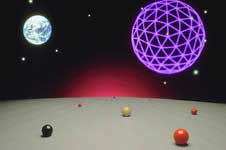Example of a made up algebra
Lets make up a simple algebra to illustrate the issues. Lets say each entity in our algebra consist of two real numbers and we will represent it by putting them in brackets and separating them with a comma as follows:
(x,y)
As with real numbers we can have constants (3,-4) and variables (x,y) and we can relate them with equations:
(x,y) = (3,-4)
We can define operations on them such as addition, subtraction, multiplication, division and powers although not every algebra needs to have all these operations defined on them. Some algebras may only have an addition operation while others may only have a multiplication operation.
Lets say that in our algebra addition means adding the corresponding elements so,
(1,2) + (3,-6) = (4,-4)
(53,15) + (27,42) = (80,57)
(x1,y1) + (x2,y2) = (x1+x2,y1+y2)
This is quite typical of the way that addition is defined in multidimensional algebras: vectors, matrices, complex numbers, quaternions, multivectors all have addition defined in this way. There is no reason why we should not invent an algebra with addition defined differently but all the most useful algebras that I know define addition in this way.
We can also define functions on out entities such as square, square root, inverse, exponential and so on, we don't have to define these operations for every algebra, only if they are useful for the algebra that we are working on.
How do I design an Algebra?
These different algebras listed above all use the same addition and multiplication operations, the difference seems to be the number of dimensions and the way that these dimensions interact.
In all the above cases addition just adds the terms from corresponding dimensions.
Multiplication combines numbers across dimensions, if it did not then we might as well treat each dimension independently. So it is multiplication which differs between each of the above algebras and gives each its own 'flavor'.
In fact, in many cases when applying these algebras in practical cases, we may use only the multiplication operation (see group theory) for example, quaternions when applied to 3D rotations.
So it seems to me that we can define these algebras by a table showing how the multiplication operator combines each dimension with each other dimension.
Some of the key factors seem to be:
- Number of dimensions.
- Result of squaring a dimension (+1 or -1)
- Does the operation conserve distance (this seems very geometry oriented for pure algebra?)
From what I can tell the commutative and associative laws for multiplication would be determined from the table .

